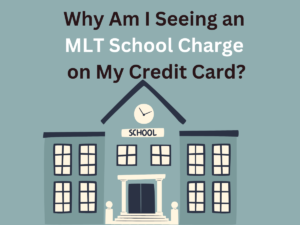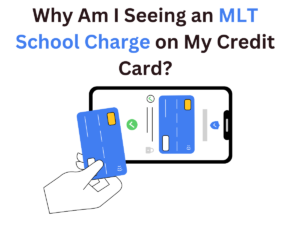In today’s digital age, where online transactions have become the norm, it’s not uncommon to occasionally spot unfamiliar charges on your credit card statement. One such charge that might leave you scratching your head is an “MLT School” fee.
If you’ve recently noticed this charge and are wondering what it means, where it came from, and whether it’s legitimate, you’re not alone. This article will explore the possible reasons behind the MLT School charge, how to verify its authenticity, and what steps you can take to address it.


What Is MLT School?
Before diving into the reasons for the charge, it’s important to understand what MLT School refers to. MLT School could stand for a variety of things, depending on the context. Here are a few possibilities: Medical Laboratory Technician (MLT) School: MLT School might refer to an educational institution or training program for medical laboratory technicians. These programs prepare students for careers in healthcare, focusing on laboratory testing and analysis. MLT as an Acronym: MLT could also stand for other organizations, businesses, or services unrelated to education. For example, it might be a shorthand for a company name, a subscription service, or even a typo on your statement. Online Learning Platforms: MLT School could be an online learning platform or course provider offering specialized training in a particular field. Without additional context, it’s difficult to pinpoint exactly what MLT School refers to. However, the most common interpretation is that it’s related to an educational program or service.
Why Are You Seeing an MLT School Charge on Your Credit Card?
There are several reasons why you might see an MLT School charge on your credit card statement. Let’s explore the most likely scenarios:You Enrolled in a Course or Program
If you or someone with access to your credit card recently enrolled in a course, training program, or workshop offered by MLT School, the charge could be related to tuition, registration fees, or course materials. Many educational institutions and online learning platforms charge fees upfront or on a subscription basis. Action Step: Review your emails or records to see if you signed up for any courses or programs recently. Check if MLT School is the provider.Automatic Subscription Renewal
If you previously signed up for a service or course through MLT School, the charge might be an automatic renewal fee. Many online platforms use recurring billing models, and if you didn’t cancel your subscription, you could be charged again. Action Step: Look for past transactions related to MLT School. If you find one, check the terms of service to see if automatic renewals are part of the agreement.Charge or Fraud
Unfortunately, credit card fraud is a common issue. If you don’t recognize the charge and didn’t authorize it, it’s possible that your card information was compromised. Scammers often use vague or generic names like “MLT School” to disguise fraudulent transactions. Action Step: If you suspect fraud, contact your credit card issuer immediately to report the charge and request a card replacement.Family Member or Authorized User
If you share your credit card with a family member or have authorized users on your account, someone else might have made the purchase without informing you. For example, a spouse or child might have signed up for a course or service. Action Step: Check with anyone who has access to your card to see if they made the purchase.Third-Party Billing
Sometimes, charges appear under a name that differs from the company or service you interacted with. For example, if you signed up for a course through a third-party platform, the charge might appear as “MLT School” instead of the platform’s name. Action Step: Review your purchase history and receipts to see if the charge aligns with any recent transactions.Free Trial Conversion
If you signed up for a free trial with MLT School or a related service, the charge could be the result of the trial period ending and the subscription converting to a paid plan. Action Step: Check your email for any trial expiration notices or subscription confirmations.How to Verify the MLT School Charge?
If you’re unsure about the legitimacy of the charge, follow these steps to verify it: Review Your Records: Go through your emails, receipts, and bank statements to see if you can find any reference to MLT School or a related service. Check with Family Members: Ask anyone who has access to your credit card if they made the purchase. Contact the Merchant: If you can identify MLT School as a specific company or institution, reach out to their customer service team to inquire about the charge. Provide them with the transaction details, such as the date and amount. Search Online: Look up “MLT School” online to see if it matches any known businesses or services. Be cautious of phishing sites or scams. Monitor Your Account: Keep an eye on your credit card statement for any additional unfamiliar charges. Fraudulent activity often involves multiple small transactions.What to Do If the Charge Is Unauthorized?
If you determine that the MLT School charge is unauthorized or fraudulent, take the following steps: Contact Your Credit Card Issuer: Report the charge to your credit card company as soon as possible. Most issuers have a zero-liability policy for fraudulent transactions, meaning you won’t be held responsible for the charge. Dispute the Charge: File a dispute with your credit card issuer to have the charge investigated and potentially reversed. Request a New Card: If you suspect your card information was compromised, request a new card with a different number to prevent further unauthorized charges. Monitor Your Credit: Keep an eye on your credit report for any signs of identity theft. You can request a free credit report from major bureaus like Equifax, Experian, and TransUnion.
Preventing Unauthorized Charges in the Future
To avoid similar issues in the future, consider these tips: Use Strong Passwords: Protect your online accounts with strong, unique passwords and enable two-factor authentication where available. Monitor Your Statements: Regularly review your credit card and bank statements for any unfamiliar charges. Be Cautious with Free Trials: Read the terms and conditions before signing up for free trials, and set reminders to cancel if you don’t want to continue the service. Use Virtual Cards: Some credit card issuers offer virtual card numbers for online purchases, which can help protect your main card number. Educate Family Members: If you share your card with others, make sure they understand the importance of notifying you before making purchases.Why Might Orbilon Technology Be Related to an MLT School Charge on My Credit Card?
If you notice orbilon technology charges on your credit card, it might indicate recent transactions related to your enrollment at an MLT school. These charges could be for tuition, course materials, or registration fees. Always review your billing statements to ensure accuracy and timely communication with the school if discrepancies arise.
